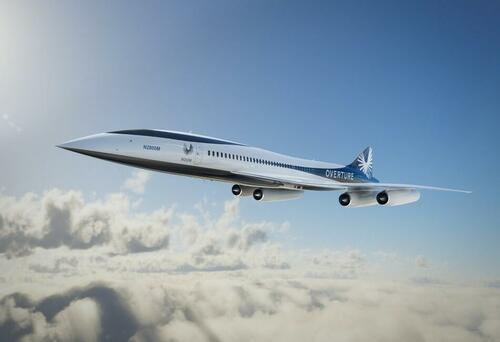‘Sustainable’ Supersonic Plane Already Has Dozens Of Pre-Orders From Airlines, Government
In the nearly 20 years since the supersonic Concorde was retired, a new aeronautics company has developed a “sustainable” new airplane, that will shuttle between 60 and 80 passengers up to nearly 5,000 miles at a time, flying at Mach 1.7.
Denver-based Boom Supersonic has developed the “Overture,” which will run on “100% sustainable aviation fuel” (SAF), powering four smaller wing-mounted engines to keep weight and temperature balanced. It will also incorporate carbon composite materials for a lightweight, yet robust air frame.
The company has already scored contracts from the US Air Force and two airlines – with United Airlines committing to 15 aircraft once safety requirements are met, as well as an option to purchase 35 more. Japan Airlines has also pre-ordered 20 of them, while the company is creating custom applications for the government.
SAF uses different types of waste products, such as used cooking oil to animal fat, to deliver the same performance as conventional jet fuel – just with a (claimed) reduced carbon footprint.
“Environmental performance is being considered in all aspects of Overture, from design and production to flight and end-of-life recycling,” reads Boom’s website. “The engineering team prioritizes circularity by repurposing used tooling, recycling components on the shop floor and leveraging additive manufacturing techniques that result in less manufacturing waste and lighter, more fuel-efficient products.”
As the NY Post notes, the plane will reach various destinations much faster than conventional airliners.
New York City to London:
Current travel time: Approximately 7 hours
Overture travel time: 3 hours 30 minutes
Los Angeles to Sydney:
Current travel time: Approximately 15 hours
Overture travel time: 8 hours
Tokyo to Seattle:
Current travel time: Approximately 9 hours
Overture travel time: 4 hours 30 minutes
“With no afterburners and buzz-free engines, Overture’s takeoffs will blend in with existing long-haul fleets, resulting in a quieter experience for both passengers and airport communities,” reads Boom’s site, which notes that the signature sonic boom created when an aircraft exceeds the speed of sound will happen over the ocean so as not to disturb people on the ground.
Tyler Durden
Wed, 08/17/2022 – 23:30

